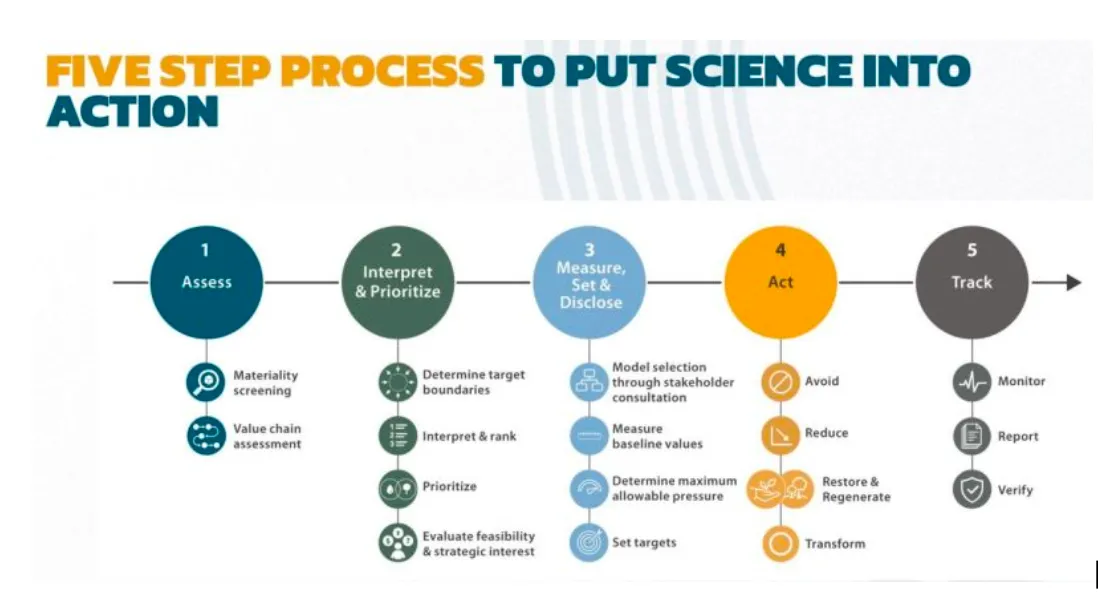The Science-Based Targets for nature have just been released. Here’s what businesses should know about them.
The Science-Based Targets Network, a collaborative effort comprising more than 80 environmental non-profits and mission-driven organizations, has recently introduced the first-ever science-based targets for nature. These groundbreaking targets complement the existing climate targets that have already been set by over 2,600 companies through the Science-Based Targets initiative. With the aim of realizing a future that is both equitable and characterized by net-zero emissions and positive impacts on nature, these targets enable companies to assess their impact on the environment and take necessary action.
It’s worth noting that the SBTN framework has a strong link to planetary boundaries. It aims to offer targets and trajectories to companies compatible with the return into the safe operating zone.
Biodiversity is one of the 5 pillars of the SBTN. Research has proven that the biodiversity crisis is just as serious as the climate crisis. In this blog post, we will explore the significance of SBTN, how they differ from traditional SBTs, and the impact they can have on preserving our planet's natural environment. Here's what you should know.

Source: Science-based Targets website.
What are Science-Based Targets (SBTs)?
Before diving into SBTN, it's important to grasp the concept of Science-Based Targets (SBTs) in general. These targets provide a clearly-defined pathway for companies to help prevent the worst impacts of climate change and future-proof business growth. The 5 pillars, outlined on the graph above, are: Climate, Ocean, Biodiversity, Land and Freshwater.
The longest standing SBTs are those related to climate – specifically the SBTi for carbon. This is an ambitious environmental goal which aligns companies' greenhouse gas emissions reductions with the global goals set at the Paris Agreement – limiting global warming to well below 2 degrees Celsius. By adopting carbon SBTs, companies take responsibility for their carbon footprint and commit to taking actions that contribute to a low-carbon future.
How do Science-Based Targets for Nature differ?
The SBTN are an innovative extension of SBTs that go beyond carbon emissions reduction. They recognize that business leaders have a critical role to play in ensuring the survival of our natural environment. They aim to provide a framework for companies, governments, and organizations to set targets that safeguard and restore nature, ensuring the long-term sustainability of our planet.
What is the significance of the SBTN?
Nature is facing unprecedented threats, including natural ecosystem conversion, pollution, climate change and overexploitation. The consequences of these are nature loss and species extinction. The SBTN recognize that addressing climate change alone is insufficient to protect the planet. By integrating nature conservation into business strategies, SBTN encourage a holistic approach that considers the interdependence between ecosystems and human well-being. They empower companies to reduce their negative impact on biodiversity, preserve freshwater resources, regenerate land, reverse nature loss and actively contribute to preserving our planet's natural resources.
The SBTN have the potential to drive transformative change at a global scale for a nature-positive future. By encouraging companies to adopt ambitious targets that align with scientific evidence, the framework can help leaders mobilize resources, promote innovation, and accelerate the shift towards sustainable business practices. Achieving SBTN goals will not only safeguard biodiversity but also generate social and economic benefits, including improved livelihoods, enhanced resilience, and strengthened ecosystem services.
How can you implement and track your progress with SBTN?
The Science-based targets network identifies this as a 5 step process. As part of its first release in 2023, SBTN has developed detailed technical guidance for the first 3 steps of the process with additional guidance on the final steps (Act and Track) coming in 2024.

Source: Science-based Targets website.
1. Assess
Begin by gaining a comprehensive understanding of your organization's environmental impacts through the Science-based targets network's sector-level materiality screening. Joining the Corporate Engagement Program allows you to tap into the collective knowledge and experience of other participating companies, as well as the expertise offered by SBTN's team. There is an extensive directory of expert advisors who can offer valuable guidance throughout the process, along with a range of onboarding resources designed to help you get ready for action.
2. Interpret and prioritize
Start by evaluating the comprehensive impacts your organization has on nature across the entire value chain, identifying potential environmental effects and target-setting opportunities. Here, it’s important to identify high stake locations, as traceability is a necessary condition for conducting an SBTN process.
Sector-level materiality evaluation
Leverage the SBTN's sector-level materiality screening tool to obtain a rapid overview of the specific issue areas linked to the economic activities within your sector.
Value chain assessment
Estimate the locations and levels of impacts occurring throughout your value chain, considering both the different tiers of your supply chain and geographical areas involved.
3. Measure, set and disclose
Measurement
Begin by gathering baseline data to establish a starting point for your priority science based targets and specific locations.
Target Setting
Based on the material impacts identified, establish targets for freshwater, land, and climate (in alignment with the Science-Based Targets initiative). While biodiversity is partially covered within the freshwater and land targets, the development of comprehensive analysis for biodiversity is underway. Ocean targets are currently in the early stages of development and are expected to be available in 2024. The validation process for company targets is currently undergoing pilot testing.
Target Disclosure
Throughout the journey of implementing science-based targets for nature, companies will monitor and report on their progress, making it essential to disclose this information to the public. Transparency and accountability play a key role in driving positive change.
3. Act
In the Initial Guidance for Business Leaders, the Science-Based Targets Network introduced the Action Framework to provide a comprehensive approach for companies. Referred to as AR3T, this framework encompasses a range of actions that aim to avoid future impacts, reduce current impacts, regenerate and restore ecosystems, and transform the systems in which companies operate. The AR3T Action Framework is based on the mitigation hierarchy outlined in the International Financial Corporation's (IFC) Performance Standard 6.
5. Track
It is crucial for companies to track and report their progress to ensure accountability and the integrity of their validated targets. As an interim solution, companies setting targets in 2023 can use an action plan to outline their implementation steps and monitoring approach. This plan can be refined once the validation pilot concludes in 2024, before full guidance is provided.
Monitoring and measurement approaches will vary depending on the type and scale of targets. Different actions, such as avoiding, reducing, regenerating, restoring, and transforming, require different indicators and targets. For example, pollution reduction targets require different indicators than targets for restoring and regenerating nature.
Once the Science-Based Targets Network (SBTN) establishes an Measure, Report and Verify (MRV) system, requirements for corporate reporting will be formalized. Results from monitoring (using satellite or other technologies) and verification by third-party actors engaged by companies will also be shared.
What are the benefits of SBTN for companies?
First and foremost, SBTN provides a clear framework and guidance for setting science-based targets for nature, helping companies align their environmental goals with scientific evidence and best practices.
By setting these targets, companies can enhance their credibility and demonstrate their commitment to a nature positive economy.
SBTN also facilitate access to expertise and resources, allowing companies to leverage the knowledge and experience of a network of stakeholders. This can lead to innovative solutions, improved efficiency, and reduced environmental impacts.
Looking to get started with SBTN?
Sweep can help. Find out more here.




